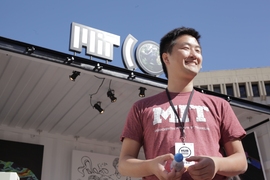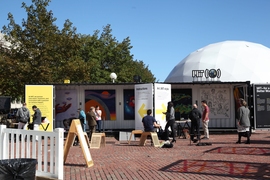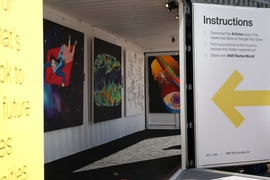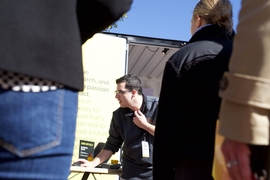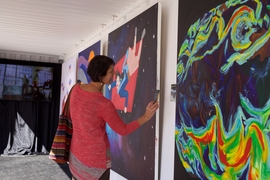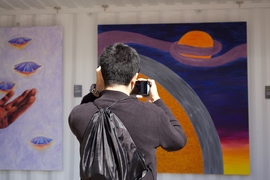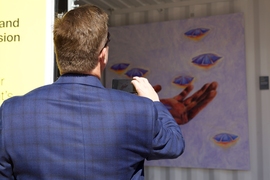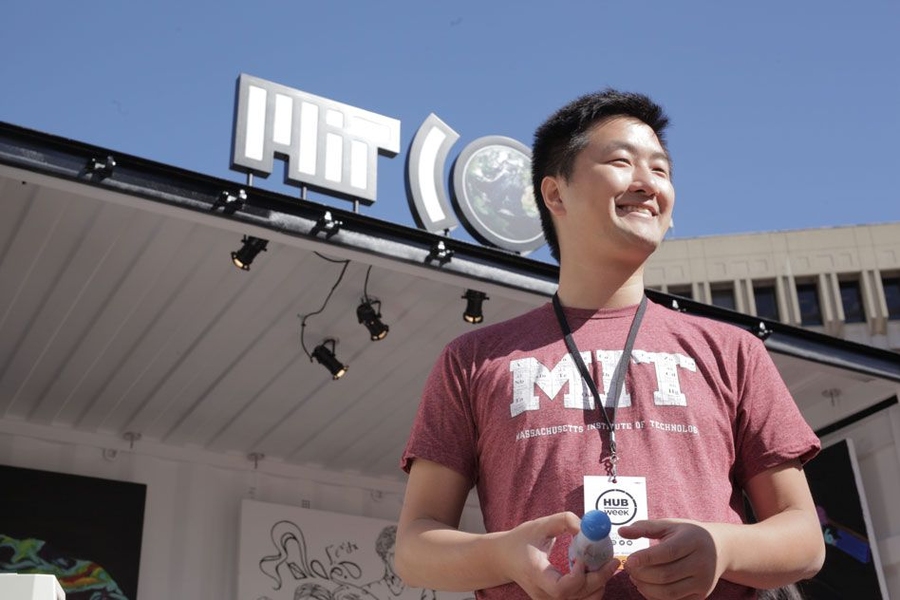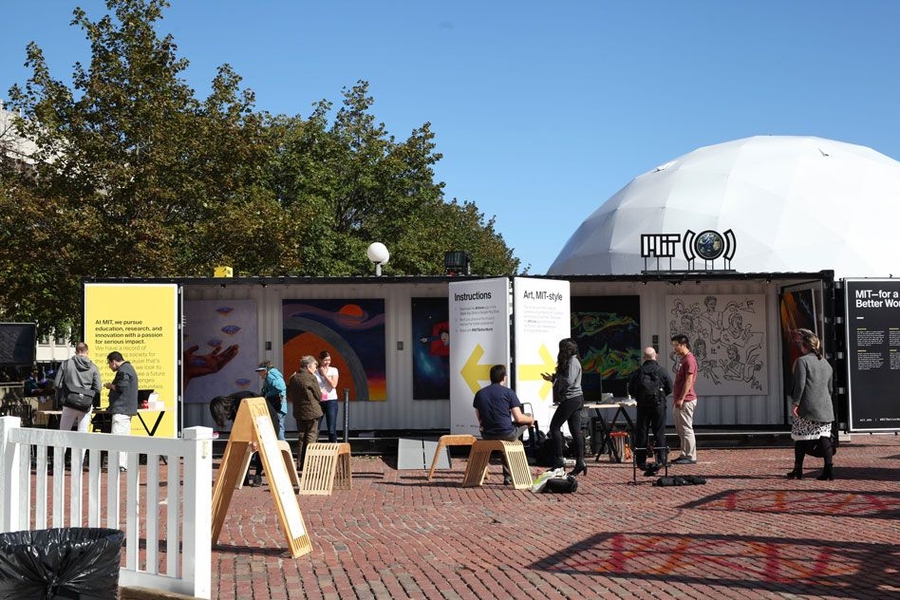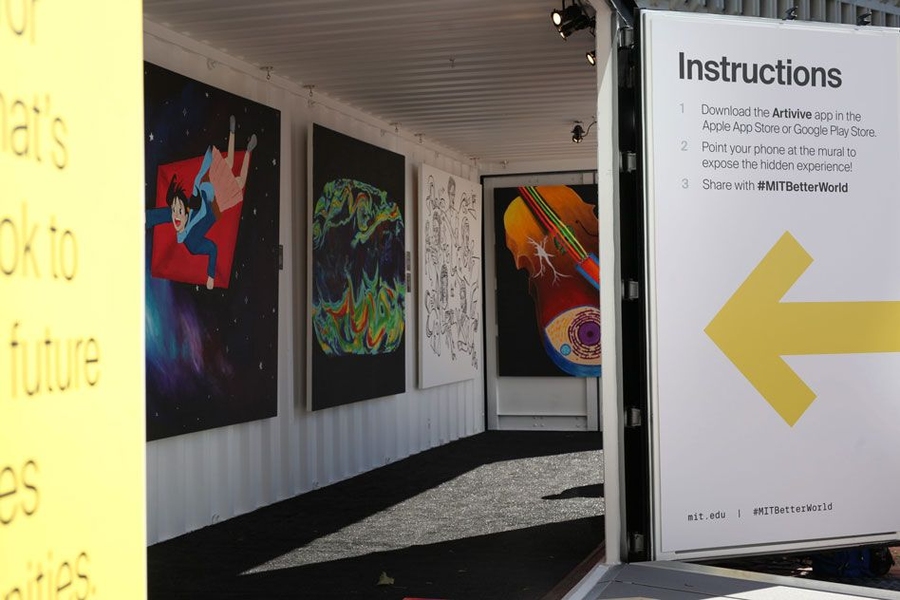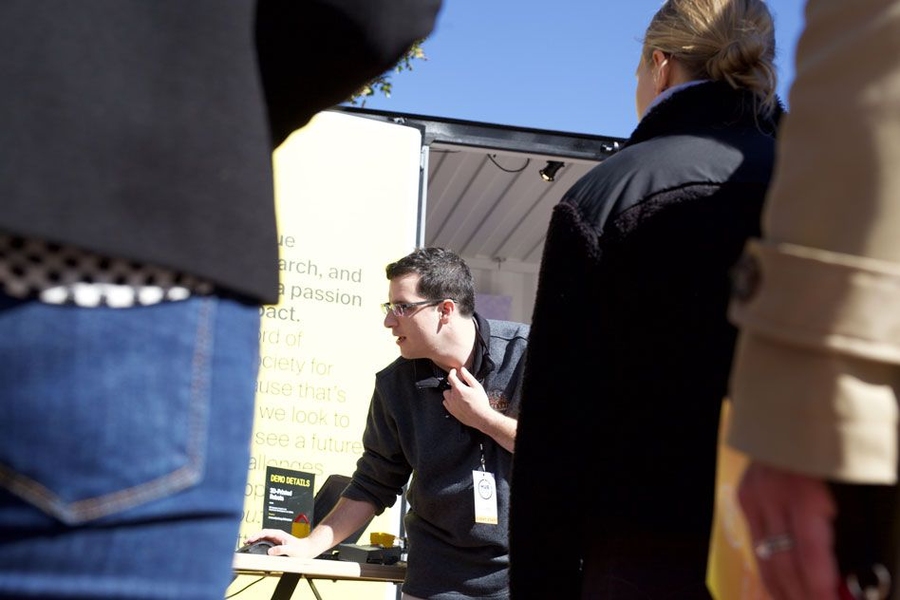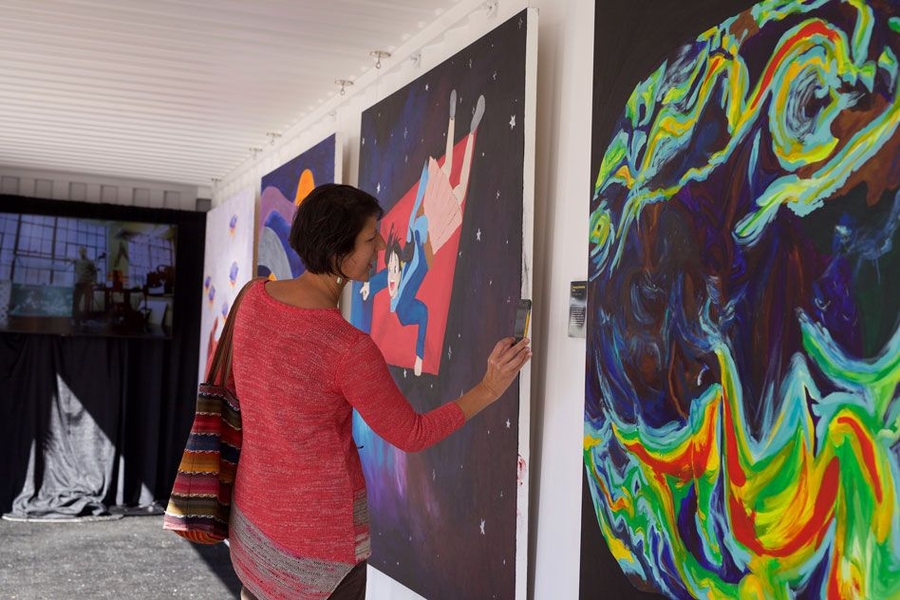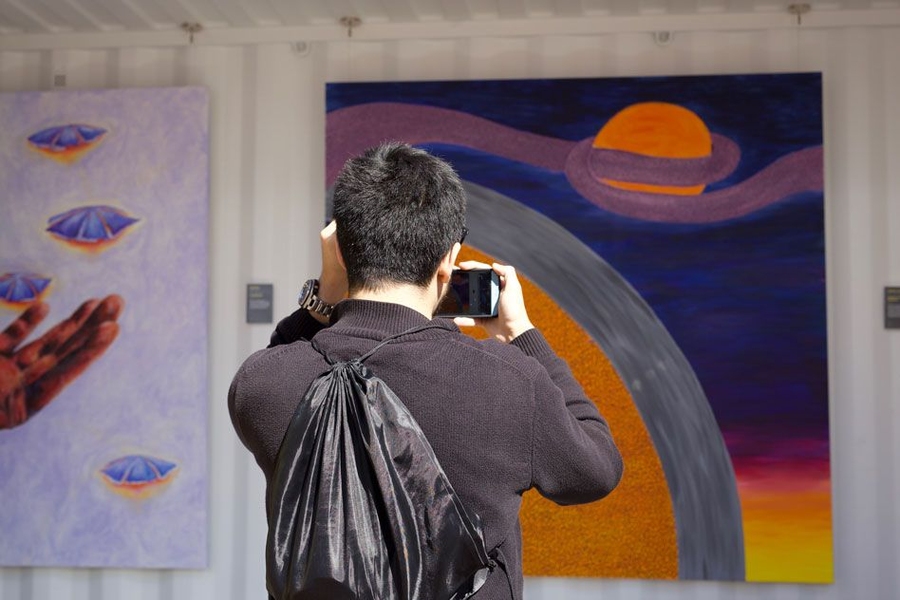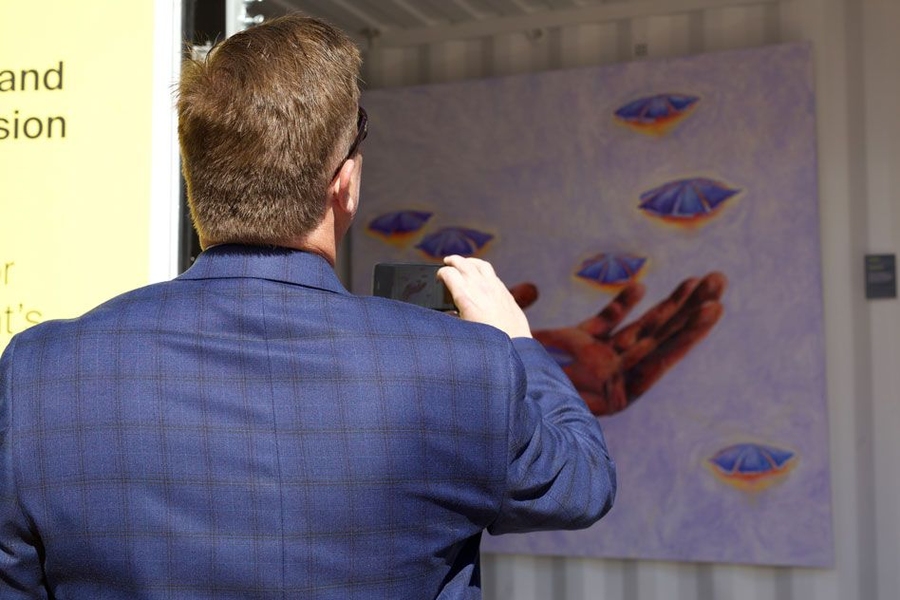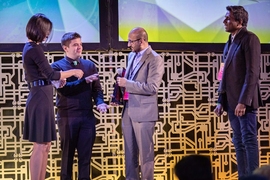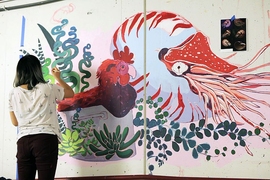The central hub of Boston’s 2017 HUBweek celebration last week was a remarkable sight: a sprawling village of over 80 shipping containers transformed into a brightly painted celebration of art, technology, and innovation, bustling with people exploring the towering crates.
Perhaps no container better celebrated the intersection of art and technology than the MIT — For a Better World exhibit, where visitors could watch colorful murals come to life with augmented reality and talk to student researchers about technology ranging from a rubbery robot that identifies leaky pipes, to an ankle exoskeleton that gives walkers a boost.
The exhibit embodied the MIT Campaign for a Better World, which has a simple goal: to use the vision and talent of people at MIT to take on urgent global challenges.
“The idea that MIT is working to make a better world is something that we want to get out to the greater community beyond MIT,” explains Barbara Malec, MIT’s creative director of Resource Development and one of the masterminds behind the display. “I think the more people know about and experience MIT, the more broadly we can continue our tradition of delivering new knowledge and solutions to the world.”
HUBweek is a celebration of creativity across Greater Boston, which took place Oct. 10 to 15. MIT is one of the co-founders of HUBweek, along with Harvard University, The Boston Globe and Massachusetts General Hospital. A new feature of this year’s festivities was The HUB, a central gathering space in Boston’s City Hall Plaza, centered around a temporary village of shipping containers, art exhibits, and geodesic domes showcasing the region’s inventiveness.
For their exhibit, Malec and senior designer Eric Keezer drew inspiration from The Borderline Mural Project, where 25 MIT-affiliated artists covered 200 feet of the tunnels under the campus with murals that can be experienced in augmented reality (AR). Pearl Lee, a senior in biological engineering who was one of the artists, took on the challenge of recruiting student artists for seven 6 foot by 6 foot murals at MIT’s HUBweek exhibit. Lee put out a call for artists in late August and worked diligently with the selected students to help them design and create their murals in just a few short weeks.
“It's all to promote the theme of MIT making a better world, so it was each artist's interpretation of that,” Lee says. “We wanted to bring together science and art, so we thought it was a really good idea to showcase that, hey look, we can be artistic, but also of course because we're nerds, we can add this [augmented reality] component and make it come to life.”
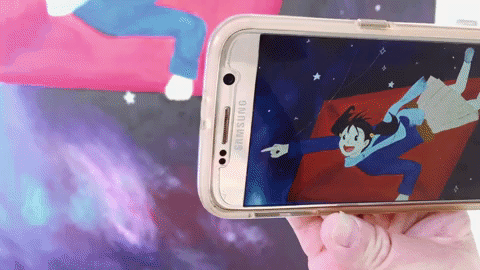
The murals were dazzling, hung on the walls of a simple, white shipping container to create what felt like an outdoor art gallery. As people continuously wandered through on Thursday afternoon, they couldn’t help but pull out their phones, download the Artvive app, and watch on their screens as animations were revealed within the murals.
At one end of the AR-enhanced exhibit, a violin splashed with cells started to play, the bow (overlaid with C15H20O6, the chemical formula for rosin) drawing back and forth across vibrating fluorescent strings. Next to it, black line drawings of women in science on a white canvas burst into color, with deep purple, yellow, and blue hues. In the most data-driven mural, rainbow swirls representing particles moving on winds around Earth were set in motion, rotating in clockwise and counterclockwise circles. And then there was a little girl on a kite flying through space on a journey of exploration and discovery as a beaver in a space suit drifted by.
The student artists are Megan Ochalek, Talia Blum, Shin Chang, Violetta Jusiega, Khanh Nguyen, Kasturi Shah, and Tingxiao “Charlotte” Sun.
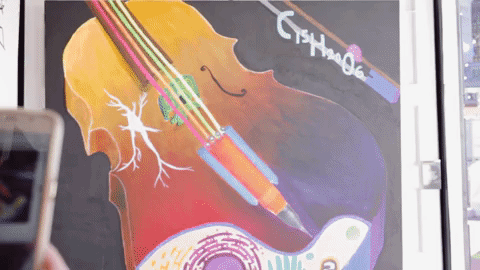
While the murals were an artistic interpretation of MIT — For a Better World, the demos in front of the container offered concrete examples of how MIT researchers are tackling big problems.
One was Robot Daisy, a soft, rubbery robot that looks like an oversized badminton birdie. The bot, which is designed to move through municipal water pipes, detects leaks when suction created by escaping water tugs on its sensor-laden wings. The idea is to identify leaks at an early stage: Currently water systems lose 20 percent of their water to leaks, and most of the leaks are not found until they are big enough to do damage to nearby streets, homes, and businesses. PhD candidate You Wu, master’s candidate Tyler Okamoto, and senior Elizabeth Mittmann, from the Mechatronics Research Lab in the Department of Mechancial Engineering, were on site Thursday talking to people about the device and encouraging them to pick it up and play with it.
“We got a lot of traffic here, all Boston locals,” Wu told MIT News. “And every time I mention, ‘have you seen a water main break?’ They're like ‘yup,’ and they care about this.”
“There's all different types of people here, and I felt like I could make a connection with all of them,” Okamoto added.
Pipeguard Robotics, the team behind Robot Daisy, also took home the grand prize at Saturday’s Demo Day pitch competition.
Matt Weber, a student in the Harvard-MIT Program in Health Science and Technology, arrived Thursday wearing robotic ankle exoskeletons, or “exoboots,” which he said attracted some strange looks on the subway. The battery-powered device reduces calf strain during walking, using motors and electronics. “With every step you take, it gives you a little kick to get into the next step,” he told a group that gathered to ask questions.
Weber, who works with MIT Professor Hugh Herr, says the device was initially developed for the military, but the researchers are now turning their attention to other uses, such as for people who have weakened calves due to stroke or muscular dystrophy, or people who walk long distances for work.
In contrast to the visual feast of the MIT — For a Better World exhibit, the MIT Media Lab’s City Symphonies exhibit offered an auditory treat. Passersby couldn’t help but pause at the black-curtained opening of the simple, gray container and step through the curtains. First, they were drawn in by a bold, unusual symphonic music. Next, they were entranced by two large high-definition displays playing vibrant scenes from nature and city settings.
The exhibit, one of the few with a sound component, represents the City Symphony projects headed by Professor Tod Machover at the MIT Media Lab. In each City Symphony, technologies developed by Machover and his Opera of the Future Group allow anyone to contribute audio, video, original compositions using Hyperscore software, voices, and more, and to help shape the feel and story of each “symphony” through a new kind of collective creativity. Machover then weaves these materials into a piece of music that’s performed by the major orchestra in that city. So far, Machover and his team have created City Symphonies for cities around the world, including Toronto, Edinburgh, Perth, and Detroit, and a large project is currently underway in Philadelphia.
“I think that's one of the really neat things about it, is that it brings together a group of people who otherwise wouldn't meet each other but are connected through music and careful listening,” explains Charles Holbrow, a PhD candidate at the Media Lab who spoke with visitors at the exhibit. “We have been asked by HUBweek to create a City Symphony right here in Boston, so right now we're kind of asking the question, we want to do this in Boston — how are we going to do it? That's why we're here. We want to meet people who live in greater Boston and ask them, OK, what does Boston sound like to you?”
